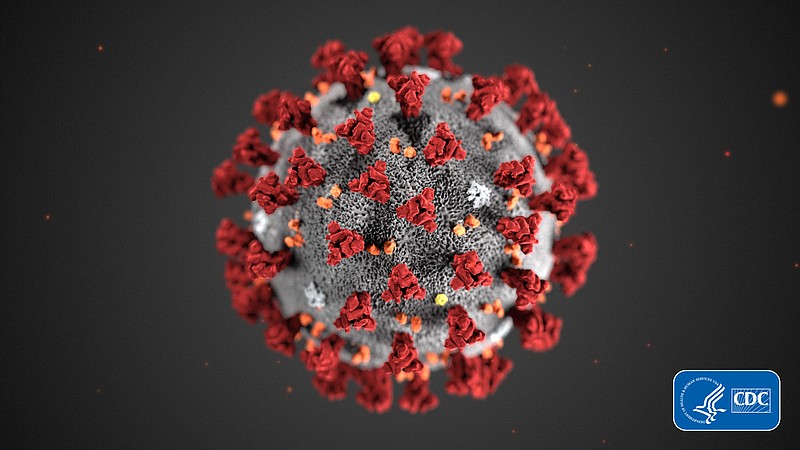As a service to our readers, The Sentinel-Record publishes updates released by the city of Hot Springs and the state of Arkansas.
Gov. Asa Hutchinson held his weekly press update Tuesday at the state Capitol. The following stats were posted Tuesday on the Arkansas Department of Health website:
• 220,797 cumulative confirmed cases, up 841 from Monday.
• 1,417.71 rolling seven-day average of new confirmed cases, down 179.15 from Monday.
• 2,288,594 PCR test reports, up 6,383 from Monday.
• 9.6% cumulative PCR infection rate, no change from Monday.
• 293,600 vaccine doses received, up 18,600 from Monday.
• 147,609 doses given, up 13,647 from Monday.
• 52,797 cumulative probable cases, up 490 from Monday.
• 19.4% cumulative antigen infection rate, down from 19.5% Monday.
• 20,940 active confirmed and probable cases, down 1,852 from Monday.
• 248,238 recoveries of confirmed and probable cases, up 3,142 from Monday.
• 1,265 hospitalizations, up two from Monday.
• 209 cases on a ventilator, down seven from Monday.
• 394 ICU admissions, down 16 from Monday.
• 3,621 confirmed deaths, up 36 from Monday.
• 765 probable deaths, up seven from Monday.
• 1,761 nursing home deaths, up 14 from Monday.
• 6,451 cumulative confirmed cases in Garland County, up 13 from Monday.
• 55.57 rolling seven-day average of new confirmed cases, down 19.02 from Monday.
• 80,010 PCR and antigen test reports, up 247 from Monday.
• 59,380 private lab reports, up 211 from Monday.
• 20,630 public lab reports, up 36 from Monday.
• 9.0% cumulative PCR infection rate, no change from Monday.
• 540 active confirmed cases in Garland County, down 75 from Monday.
• 5,756 recoveries of confirmed cases in Garland County, up 88 from Monday.
• 1,123 cumulative probable cases in Garland County, up nine from Monday.
• 133 active probable cases in Garland County, down 21 from Monday.
• 155 confirmed deaths, no change from Monday.
• 32 probable deaths, no change from Monday.
The state's polymerase chain reaction-confirmed infection curve traced a point 35% lower than the Jan. 11 peak Tuesday, but Hutchinson said the virus continues to menace public health.
"We still have the virus in every part of the state," he said. "Our new cases are still significantly high, even though they're less than they were two weeks ago. We're going to continue to have challenges until our vaccination is permeating our society and population here in Arkansas."
The Health Department reported half of the almost 300,000 vaccine doses the state received through Monday have been injected. The number doesn't include 80,700 doses provided for nursing home staff and residents through a federal contract with Walgreens and CVS pharmacies. Fewer than 10% of those doses have been injected.
"The state plan we have control over, 50.3% of doses are out," Hutchinson said. "The federal partnership we don't have as much control over is lagging behind. But they have assured us they have schedules with different long-term care facilities to do the vaccination in the coming days, and that will be completed by the end of the month."
The state said the federal contract over-allocated doses for nursing homes.
"The allocation was based off of licensed beds with a ratio of staff to support those beds," said retired Air Force Col. Robert Ator, the program manager for the state's vaccine deployment. "That occupancy rate was not there. It was an over allocation.
"By the end of this month we should be close to done with the federal program. We're working with Walgreens and CVS to reclaim those doses. We hope to within the next week or so turn those loose on the 1B population and getting it into the arms of Arkansans."
Phase 1B of the state's vaccination plan began Monday, qualifying educators, day care workers and people 70 and older for vaccination.
Dr. Jose Romero, the state's secretary of health, said the Health Department has sent specimens it suspects contain the genetic sequence of the more contagious permutation of the virus to the Centers for Disease Control and Prevention.
"We have already sent specimens to the CDC that were suspicious," he said. "They have not come back as positive. At the current moment, eight specimens are at the CDC being sequenced.
"The CDC predicts by March this virus will be the predominant virus in the United States. The more fit the virus, the more able it is to transmit itself and to propagate itself within the population. It's about 50 to 70 times more transmissible than the current virus in our environment, which means we have a greater chance of infecting another individual if we are positive."
Romero said the more contagious strain could cause another spike in the infection curve and make vaccine distribution more urgent.
"In order to bring the virus under control, we're going to have to have a larger number of individuals vaccinated," he said.
